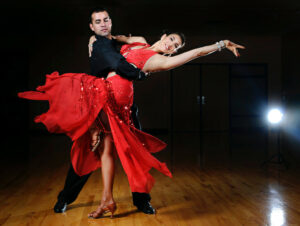A
B
Bandoneón — An accordion like musical instrument originally created to provide missionaries with portable pipe organ music for religious services in remote locales which has been adopted by tango musicians to create the mournful and soulful sound of modern tango music.
Basico — The basic pattern. There are several basic patterns, the most common of which is the 8-count basic.
Bicicleta — Bicycle: A circular movement of the feet led by the man in the vertical plane with the couples feet pressed together as in a barrida.
Boleo — From bolear – To throw: a boleo may be executed either high or low. Keeping the knees together, with one leg back, swivel and return on the supporting leg with a whipping action of the working leg.
C
Cabeceo — (from cabeza; head): Traditional technique for selecting dance partners from a distance at the milongas in Buenos Aires by using eye contact and head movements.
Calesita — Carousel; the merry-go-round: A figure in which the man places the lady on one foot with a lifting action of his frame and then dances around her while keeping her centered over, and pivoting on, her supporting leg.
Cambio — Change: as in cambio defrente, change of the front or face; or cambio parejas, change the couple (change partners).
Caminada — The walking steps; a walking step.
Caminar — To walk: The walk is similar to a natural walking step, but placing the ball of the foot first instead of the heel. Sometimes taught that the body and leg must move as a unit so that the body is in balance over the forward foot. Another style requires stretching the working leg, placing the foot, and then taking the body over the new supporting foot regardless of direction. Walks should be practiced both forward and backward for balance, fluidity, and cat-like gracefulness.
Candombe — A type of dance originally danced by the descendants of black slaves in the Rio de la Plata region and still performed in Montevideo, Uruguay. Music of African origin with a marked rhythm played on a “tamboril” (a kind of drum). It survives today as a rhythmic background to certain milongas such as Azabache by Miguel Caló, Carnavalito by Lucio Demare, Estampa del 800 by Francisco Canaro and the very popular recordings by Juan Carlos Cacérès.
Canyengue — A very old style of tango from the 1900s to the 1940s. The music from this era had a faster or peppier 2/4 tempo so the dance had a rhythmic flavor similar to that of modern milonga. A very close embrace was used as well as some unique posture and footwork elements. The tango of the arrabal.
Compás — Beat, as in the beat of the music. The walking count or impulse of each measure, the simplest element of each piece of music.
Cuartas — Poses: Dance lines struck and held as dramatic flourishes at the end of a song. Large dramatic ones are used for stage or fantasia dancing, smaller softer versions occasionally in Salon style, and not used in Milonguero style at all.
Cunita — Cradle: A forward and backward rocking step done in time with the music and with or without chiches, which is useful for marking time or changing direction in a small space. This movement may be turned to the left or right, danced with either the left or right leg forward, and repeated as desired. See Hamaca.
D
E
8-Count Basic (Academic Basic) — The first figure usually taught to beginning students after the walking steps. See Basico. The 8-count basic includes elements which are used throughout the dance, although the complete figure itself is not much used for dancing socially. The name refers to counts in music, however, the man is not constrained to rigidly mark a step on each count or beat of the rhythm. He is free to hold or to syncopate, or cut the beat, as the music moves him or as space on the floor around him allows. The figure may be danced into or out of at various points and is not always entered at the beginning and there are shortcuts within the 8-count basic.
Enganche — Hooking; coupling; the little hook: Occurs when a partner wraps a leg around the other’s leg, or uses a foot to catch and hold the other’s foot or ankle.
Enrosque — From enroscar – to coil or twist: While the lady dances a molinete, the man pivots on his supporting foot, hooking or coiling the working leg behind or around in front of the supporting leg
Entrada — Entrance: Occurs when a dancer steps forward or otherwise enters the space between their partners legs without displacement.
F
G
H
I
J
K
L
M
N
O
Ocho — Eight (pl. ochos); Figure eights: A crossing and pivoting figure from which the fan in American tango is derived. Executed as a walking step with flexed knees and feet together while pivoting, ochos may be danced either forward or backward and are so designated from the lady’s perspective. El Ocho is considered to be one of the oldest steps in tango along with caminada, the walking steps. It dates from the era when women wore floor length skirts with full petticoats and danced on dirt floors. Since the lady’s footwork could not be directly observed the quality of her dancing was judged by the figure she left behind in the dirt after she danced away.
P
Parada — From parar – to stop; a stop: The man stops the lady, usually as she steps crossing back in back ochos or molinete, with pressure inward at the lady’s back and at her balance hand and with a slight downward thrust, preventing further movement. When properly led the lady stops with her feet extended apart, front and back, and her weight centered. The man may extend his foot to touch her forward foot as an additional cue and element of style or he may pivot and step back to mirror her position (fallaway).
Planeo — Pivot; glide: Occurs when the man steps forward onto a foot, usually his left, and pivots with the other leg trailing (gliding behind) as the lady dances an additional step or two around him. May also occur when the man stops the lady in mid stride with a slight downward lead and dances around her while pivoting her on the supporting leg as her extended leg either trails or leads. Can be done by either the man or the lady.
Porteño (feminine; Porteña) — An inhabitant of the port city of Buenos Aires.
Práctica — An informal practice session for tango dancers.
Q
Quebrada — Break; broken: A position where the lady stands on one foot with the other foot hanging relaxed behind the supporting foot. Sometimes seen with the lady hanging with most of her weight against the man. Also a position in which the dancer’s upper body and hips are rotated in opposition to each other with the working leg flexed inward creating a broken dance line.
R
S
Sacada — The most common term for a displacement of a leg or foot by the partner’s leg or foot. Occurs when a dancer places their foot or leg against a leg of their partner and transfers weight to their leg so that it moves into the space of and displaces the partner’s leg.
Salida — From salir – to exit; to go out: The first steps of dancing a tango, or a tango pattern, derived from “¿Salimos a bailar?” {Shall we (go out to the dance floor and) dance?}.
T
Tanda — A set of dance music, usually three to five songs, of the same dance in similar style, if not by the same orquesta. The tandas are separated by a brief interlude of non-tango music called a “cortina” (or curtain) during which couples select each other. It is customary to dance the entire tanda with the same partner unless the man is rude or very disappointing as a dance partner, in which case the lady may say gracias (thank you) and leave
Tanguero — (feminine; Tanguera) Refers to anyone who is deeply and seriously passionate about any part of tango, such as its history, music, lyrics, etc. In Argentina most tangueros are scholars of lunfardo, music, orchestrations, Gardel, etc. One can be a tanguero without being a milonguero and a milonguerowithout being a tanguero (very few milongueros would be referred to as tangueros). And of course, one can be an extremely good tango dancer without being either, such as stage dancers, who are quite disdained by real milongueros and tangueros, unless they go the extra distance and become milongueros by going to the milongas, and/or tangueros as well.
Traspie — Cross foot; triple step: A walking step with a syncopated cross. Using two beats of music the dancer does step-cross-step beginning with either foot and moving in any direction.
U
V
Vals — Argentine waltz: Sometimes referred to as Vals Criollo, or Vals Cruzada, and danced to what is arguably the most beautiful dance music anywhere (editorial bias!:-).
Volcada — from Volcar – to tip-over or capsize; a falling step: The leader causes the follower to tilt or lean forward and fall off her axis before he catches her again. The process produces a beautiful leg drop from her. The movement requires the support of a close embrace.
W
X
Y
Yumba (zhoóm-ba) — A phonetic expression that describes the powerful, dramatic, and driving musical accent of a moderate or even slow tempo which is characteristic of the music of Osvaldo Pugliese.
Yumba (zhoóm-ba) — A phonetic expression that describes the powerful, dramatic, and driving musical accent of a moderate or even slow tempo which is characteristic of the music of Osvaldo Pugliese.
Z
Zapatazo — Shoe taps: A dancer taps their own shoes together.
Zarandeo — A vigorous shake to and fro; a swing; a push to and fro; to strut about: In tango, it is the swinging back and forth, pivoting in place on one foot, marked to the lady in time with the music.




